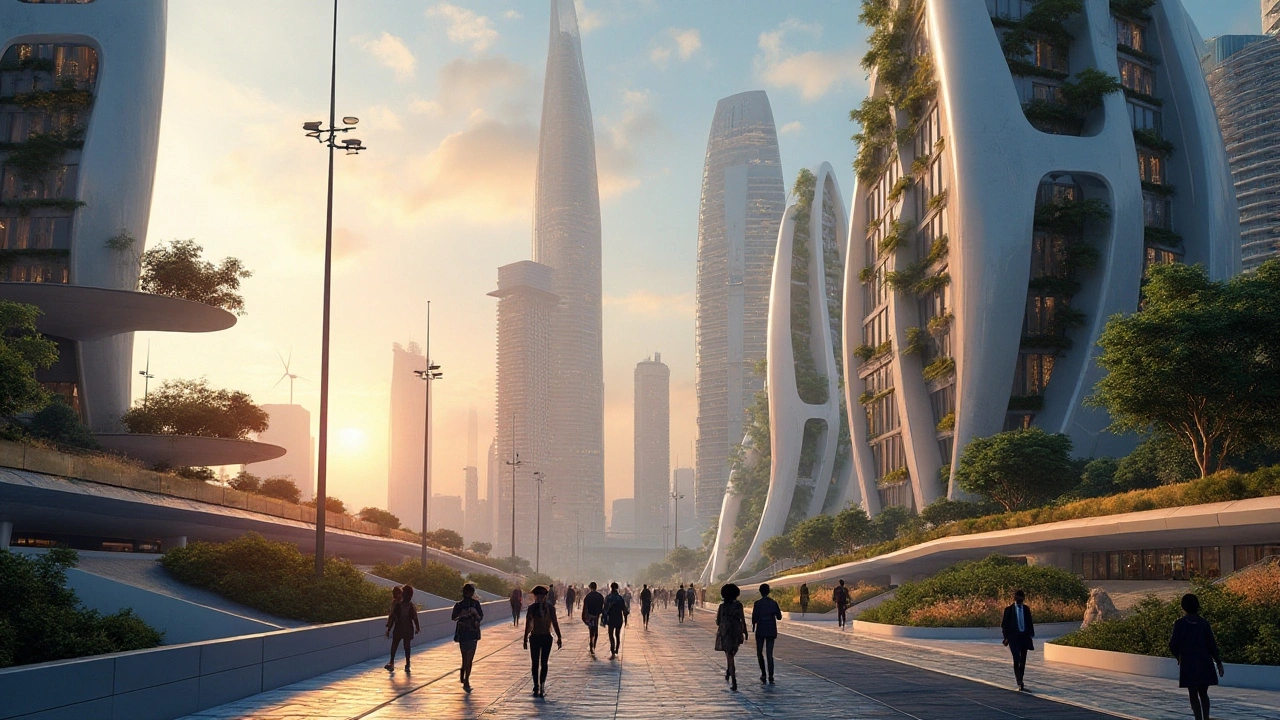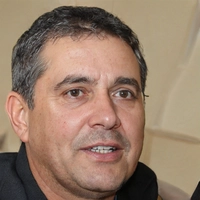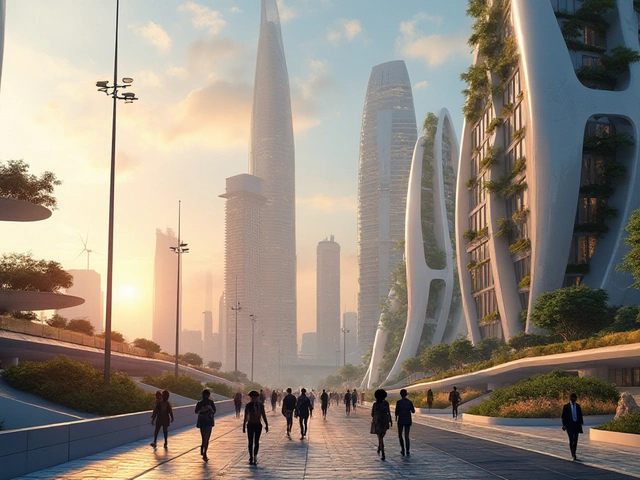The art world is no stranger to transformations, yet every so often, a movement emerges that offers fresh perspectives and bold visions. Neo-Futurism stands as the beacon of such change, melding the imaginative allure of speculative design with the demands of today’s society.
Emerging from the ripples of classical Futurism, this movement embarks on a journey to blend art, architecture, and the boundless possibilities of technology. Not just a style, Neo-Futurism reflects a deeper conversation about our collective future, intertwining visionary architecture with sustainability and cultural narratives.
Dive into the nuances of this movement as we explore how it challenges the conventions of space and form while looking toward an artistic horizon that is as promising as it is pioneering.
- The Origins of Neo-Futurism
- Key Characteristics of the Movement
- Influential Neo-Futurist Artists and Architects
- Impact on Architecture and Urban Design
- Neo-Futurism in Visual Arts and Media
- The Future of Neo-Futurism
The Origins of Neo-Futurism
Neo-Futurism is a fascinating art movement that stems from the original Futurism of the early 20th century, which itself was a bold response to the dizzying pace of technological and societal change observed at the time. Back then, artists sought to capture the spirit of modernity by rejecting the past and embracing the machine age with enthusiasm. Fast forward to the late 20th and early 21st centuries, the world had evolved drastically, and with it, the seeds for a new take on Futurism began to germinate, leading to what we now recognize as Neo-Futurism. This modern iteration took the core principles of dynamic lines and fascination with progress but recalibrated them to align with technological advancements and newfound ecological consciousness.
Neo-Futurism is primarily associated with architecture, but its reach extends across various art disciplines, encouraging creators to look beyond conventional aesthetics and infuse their work with innovative ideas. This movement found inspiration from cultural, environmental, and logistical considerations that were not part of the conversation in traditional Futurism. The rise of digital technology, the increasing importance of sustainability, and a globalized understanding of art and architecture played pivotal roles in shaping Neo-Futurism. Designers and architects like Zaha Hadid and Santiago Calatrava became the poster children for this movement, showcasing structures that were not only visually captivating but also intimately connected with the challenges of their environment.
While academia and the art world strive to define and categorize Neo-Futurism, it remains a fluid and adaptive form that often defies strict boundaries. This freedom allows it to blend eclectic influences from different cultures worldwide, especially as globalization offers more opportunities for cross-cultural exchanges. Some critics argue that Neo-Futurism might not be a distinct movement as it amalgamates ideas from previous philosophies; however, its strong emphasis on forward-thinking solutions and sustainability provides a unique framework that responds to the exigencies of the 21st century. A defining characteristic of Neo-Futurism is that it challenges artists to engage with the world around them, both aesthetically and intellectually, as they envision not just what spaces should look like, but how they operate and integrate within their surroundings.
Zaha Hadid once stated, "There are 360 degrees, so why stick to one?" This quote resonates deeply within the Neo-Futurist approach, which continuously encourages stretching boundaries and embracing multifaceted solutions.
As the movement continues to unfold, it's interesting to see how Neo-Futurism bridges modern artistic expressions with the philosophies of a rapidly advancing world. It's not restricted by traditional limitations, and its proponents actively encourage innovations that spark dialogues between function, form, and fantasy. This avant-garde approach challenges both architects and artists to reevaluate how they interact with the urban landscape and leave a lasting impact on the world, not just for today but for generations to come. This willingness to push boundaries while maintaining an eye on sustainability and connectivity takes Neo-Futurism beyond mere artistic expression, pointing towards a cooperative venture between technology and art in shaping a more integrated and harmonious future.
Key Characteristics of the Movement
Neo-Futurism is an art movement that embodies a complex fusion of styles, which demonstrates its ability to break free from traditional conventions. This movement is characterized by its emphasis on sleek, futuristic designs and innovative forms that focus on creating harmony between humankind and its environment. A key attribute of Neo-Futurism is its bold use of sculptural designs, often featuring curved lines and organic shapes that mimic the flow and movement of natural elements. This distinct style seeks to juxtapose the ancient with the futuristic, often resulting in structures and artworks that redefine conventional perceptions of space and aesthetics.
Echoing the transformative powers of technology, Neo-Futurism places a strong emphasis on modern architecture that leverages advancements to push boundaries. Materials used are often cutting-edge, including smart glass, nanomaterials, and steel, facilitating new interactions and energy efficiencies within living spaces. The movement is also recognized for its dedication to sustainability, fostering a commitment to eco-friendly practices by incorporating renewable resources and green technologies. It is not just a pursuit of aesthetic grandeur but a meaningful dialogue about sustainable futures. This commitment to sustainability is critical in an era defined by the climate crisis, as Neo-Futurists are capable of delivering both beauty and functionality without compromising the ecological integrity of the planet.
"Art and architecture hold the possibility to grasp the future, in all of its vagueness and potential," states Zaha Hadid, a renowned figure in the realm of Neo-Futurism. Her work exemplifies how Neo-Futurism can challenge established norms, delivering structures that appear to defy gravity and reshape landscapes.
Furthermore, Neo-Futurism’s commitment to technology manifests in forms that engage and prompt interactivity, enabling spaces that adapt to human presence. Urban centers inspired by this movement aim to create smart cities where infrastructure is not only functional but also adaptive and responsive. The cinematic cityscapes envisioned under this movement are marked by interconnected designs, suggesting a future in which buildings, public spaces, and their inhabitants coalesce seamlessly with evolving digital landscapes. A fundamental belief underlying this movement is that art and architecture should anticipate and facilitate new ways of living. As society progresses, Neo-Futurism offers the blueprint for spaces that cater to evolving human needs, often translated into multi-purpose areas that reshape functional urban living.
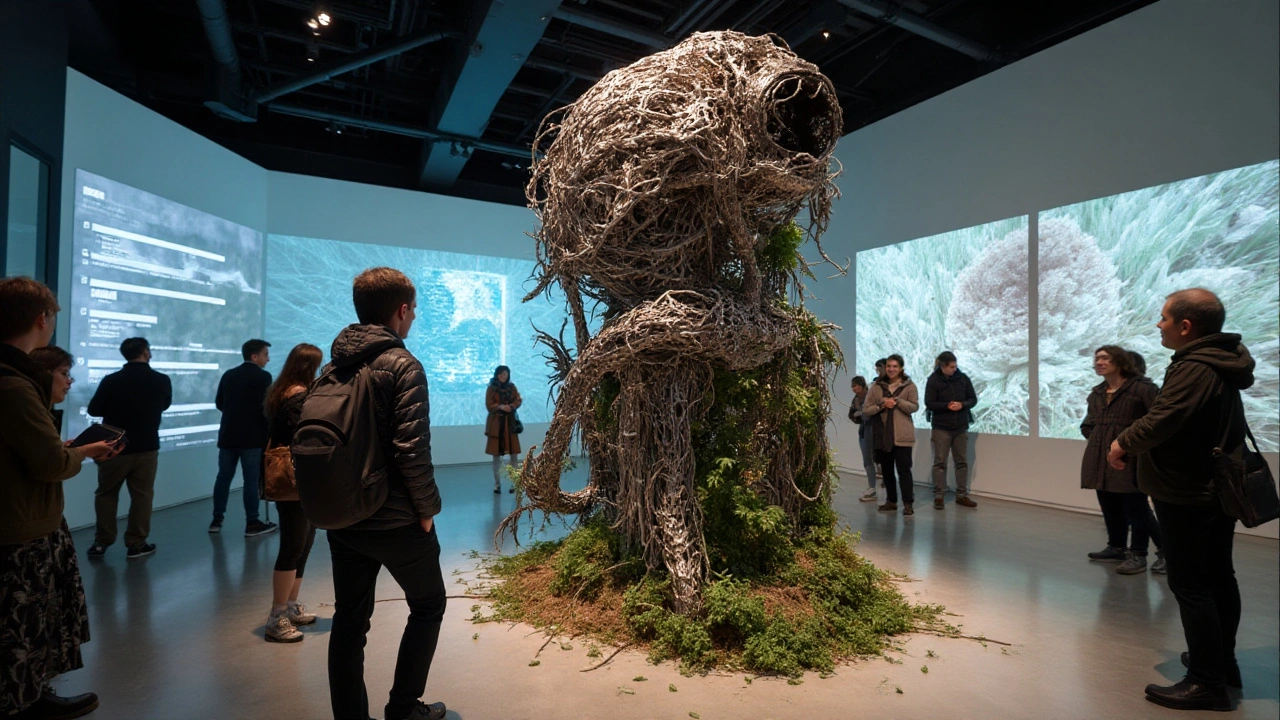
Influential Neo-Futurist Artists and Architects
The landscape of Neo-Futurism has been shaped by a cadre of visionary artists and architects, each contributing their unique interpretation of what the future could hold. One of the most notable figures is Zaha Hadid, whose architectural designs appear to defy gravity and redefine the conventions of space. Her works, such as the Guangzhou Opera House and the Heydar Aliyev Center, are not just buildings; they are living sculptures that challenge our understanding of form and function. Hadid's creations express a dynamic tension, a dialogue between the earthly and the celestial, encapsulating the essence of contemporary art.
Echoing this innovative spirit, Santiago Calatrava combines engineering precision with aesthetic wonder in his structures. Known for landmarks like the Turning Torso in Malmö and the World Trade Center Transportation Hub in New York City, Calatrava's designs are a testament to how art can inhabit the realms of both the practical and the visionary. His work often features organic forms that evoke nature's elegance, marrying the natural world with the built environment in ways that seem almost otherworldly.
Philippe Starck, another influential figure, approaches modern architecture with a playful yet purposeful ethos. His designs, ranging from furniture to entire buildings, exude a futurist ingenuity while maintaining an emphasis on functionality. Starck is driven by a philosophy that discourages excess and celebrates the beauty of essential forms. Through this lens, he shapes environments that are as forward-thinking as they are welcoming, encouraging users to interact with and appreciate their surroundings in novel ways.
Adding another layer to the Neo-Futurist tapestry is Bjarke Ingels. The Danish architect is known for his paradigm-shifting approach called 'pragmatic utopianism.' Ingels seeks to harmonize the often conflicting demands of sustainability, community, and innovation. His notable projects, such as the Amager Bakke waste-to-energy plant in Copenhagen, which doubles as a ski slope, encapsulate a commitment to eco-friendly design principles without compromising on visual or societal impact. According to Ingels, "Architecture is the art and science of ensuring that our cities and buildings fit with the way we want to live our lives."
In exploring the realm of visual arts, Marc Newson has made remarkable contributions to the movement with designs that stretch the boundaries of traditional aesthetics. His work often conveys a seamless blend of form and function, with pieces like the Lockheed Lounge earning acclaim for their inventive use of materials and a distinctly futuristic vibe. Newson’s creations are beloved not only for their ingenuity but for their ability to inspire wonder and curiosity, challenging norms and drawing us into a world where art, design, and technology coexist harmoniously.
Collectively, these artists and architects embody the spirit of Neo-Futurism, a movement that reflects a collective yearning for innovation, sustainability, and artistic exploration. Through their work, they offer glimpses into what the future might hold, transforming our perceptions and encouraging us to imagine worlds that are yet to come. Their influence is undeniable, shaping a generation of creatives who are driven by a desire not just to create, but to revolutionize the very fabric of our lived experiences.
Impact on Architecture and Urban Design
The architectural world is witnessing a transformative wave with the rise of Neo-Futurism. This movement is redefining how we perceive cityscapes, merging art and innovation in ways previously unimagined. At its core, it invites architects to design spaces that are not just functional but also deeply connected with the environment and society. Structures inspired by Neo-Futurism often feature fluid forms and sweeping lines, breaking away from the rigid geometric patterns of the past. They aim to create an immersive experience for inhabitants and foster a sense of community with the urban spaces they occupy.
As cities around the globe grapple with issues of space, sustainability, and functionality, Neo-Futurist designs offer a blueprint for urban areas of the future. Such designs often incorporate green technologies and smart urban planning to promote efficiency and ecological harmony. The trend is towards the use of sustainable materials, energy-efficient systems, and harmonious integration with nature. For example, the use of vertical gardens in skyscrapers and green rooftops contributes to reducing urban heat and improving air quality.
One of the most striking aspects of Neo-Futurism is its embrace of technology. Architects often incorporate cutting-edge technologies like smart systems and advanced materials to create 'smart buildings'. These structures not only cater to the needs of their inhabitants but also adapt to changing environmental conditions. Through the strategic use of sensors and data analytics, buildings can now manage energy usage creatively, make real-time adjustments to internal environments, and even predict maintenance requirements.
A city that embodies Neo-Futurism may exhibit features such as integrated transportation networks, renewable energy sources, and urban green spaces that are seamlessly integrated into the living environment. Interestingly, such urban designs often prioritize pedestrian-friendly zones and extensive public transport systems, reducing reliance on automobiles. These characteristics hint at a sustainable and human-centric approach that encourages connections between people, their environment, and technologies.
Quotes from renowned architects like Santiago Calatrava, known for his twisting towers and skeletal designs, capture the essence of the movement.
"The marriage of form and function, enhanced by technology, is the essence of the future."His projects exemplify how Neo-Futurism persists in pushing boundaries, crafting spaces that transcend traditional thought. By focusing on user-centric, adaptable, and aesthetic blueprints, Neo-Futurism not only reimagines the look of urban centers but also their very essence.
To see this in practice, one can look at projects like the Galaxy SOHO in Beijing or the City of Arts and Sciences in Valencia. These structures are bold in form and purpose, illustrating the endless possibilities of combining concepts of sustainability and innovation. They reflect the potential of creating vibrant, resilient urban ecosystems that cater to human experience while acknowledging the importance of ecological balance.
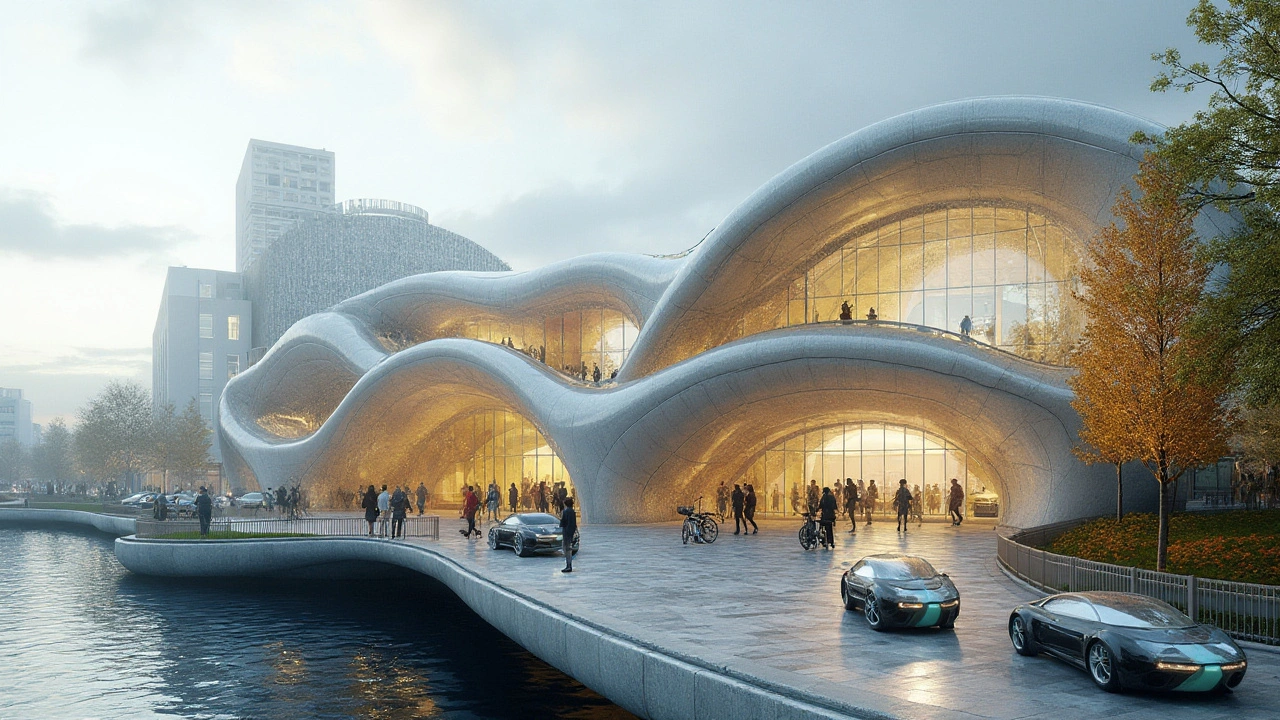
Neo-Futurism in Visual Arts and Media
Neo-Futurism's influence on visual arts and media is a testament to its profound impact, blending futuristic aesthetics with a daring vision of society's path. The movement reimagines artistic expression by incorporating cutting-edge technology, providing an immersive experience that challenges viewers to perceive art through a new lens. This approach often manifests in dynamic installations, video art, and digital creations that defy spatial limitations. By exploring the boundaries of non-traditional formats, artists can engage audiences in a dialogue that transcends geographical constraints, creating a unique blend of sensory and intellectual stimuli.
In addition to the visual spectacle, Neo-Futurism in media embraces storytelling as a vehicle for change. Futuristic narratives often center on themes of sustainability, urban life, and human interaction with technology, offering a commentary on today's societal challenges. Films, games, and virtual experiences act as vessels for these tales, allowing viewers to immerse themselves in worlds where the future's potential is both explored and questioned. Such narratives appeal to audiences' curiosity about technology's role in shaping tomorrow's culture while prompting reflection on its ethical implications today.
Exemplifying this movement, works by multimedia artists like Refik Anadol stand out. Using AI and machine learning, Anadol crafts data-driven sculptures and installations, capturing the complexity of human experience through the lens of technology. Each piece acts as an interface between the digital and physical realms, immersing observers in a visual dialogue that redefines their understanding of space and time. This innovative approach demonstrates the power of Neo-Futurism to bridge artistic expression and technological evolution.
"Art is not a mirror to hold up to society, but a hammer with which to shape it." - Bertolt Brecht
The synergy between Neo-Futurism and contemporary media also influences design trends. Artists and designers are increasingly turning to virtual and augmented reality as tools for creation and storytelling. These technologies enable unparalleled freedom in crafting experiences and environments, offering new ways to interact with art. The challenge and allure of these mediums lie in their potential to redefine the art consumption itself, decentralizing access and democratizing art in ways traditional media cannot achieve. As audiences engage with immersive platforms, they become active participants in the artistic narrative, further blurring the lines between creator and observer.
Such innovation illustrates the compelling nature of Neo-Futurism, marking a significant shift in how art is both created and consumed. The movement inspires not just artists, but also curators and collectors who appreciate its visionary potential, encouraging them to push creative boundaries. As artists continue to experiment with these tools, they not only enrich the art ecosystem but also contribute to a larger conversation about humanity's place in an increasingly digital world. The potential of Neo-Futurism to affect change and provoke thought remains immense, with its impact on visual arts and media serving as a catalyst for ongoing exploration and discovery.
In exploring the interconnectivity between art and technology, it becomes apparent that visual arts and media are not merely reflective surfaces but active players in shaping the future. As such, Neo-Futurism's ongoing evolution continues to inspire new generations of artists and audiences globally, cementing its role as a foundational pillar in the expanding landscape of contemporary art.
The Future of Neo-Futurism
As we cast our eyes toward the horizon, the influence of Neo-Futurism on contemporary art and architecture seems boundless. This movement does not simply entertain a whimsical vision of the future but actively presses on the very edges of possibility, merging aesthetics with the pragmatic challenges we face as a global society. With technology advancing at a rapid pace, designers and artists are equipped with an ever-expanding toolkit that includes virtual reality, sustainable materials, and AI-driven design processes.
One of the most captivating aspects of Neo-Futurism is its dedication to innovation while addressing pressing social issues such as climate change. In recent years, we've seen an increased application of eco-friendly materials and techniques that aim to reduce the carbon footprint of large structures. A study by the International Journal of Architecture indicates a marked increase in the integration of green technologies within Neo-Futurist projects, signaling an exciting shift towards more sustainable practices.
According to the visionary architect Zaha Hadid, the future of architecture must be "open to adventure and change." Her perspective, widely respected in the industry, underscores a core tenet of Neo-Futurism: the breaking of boundaries not just in form, but in purpose. This movement challenges artists and architects to not only imagine spaces that inspire but also to ensure these spaces contribute positively to their environments and communities.
The embrace of digital technology is another defining trait that will craft the future landscape of Neo-Futurism. With advances in AI and machine learning, there's a growing trend of employing data-driven designs that adapt over time. Such smart buildings can regulate temperatures, enhance resource efficiency, and adjust lighting based on occupancy, thus optimizing energy use. These innovations highlight the potential of blending human creativity with technological rigor to redefine what our cities might look like.
Moreover, as digital art platforms evolve, we’re witnessing how Neo-Futurism is not confined to static spaces. The movement extends into virtual environments, where digital artists are pushing boundaries without the constraints of physical limitations. This transition to virtual and augmented realities offers interactive art experiences that challenge perceptions and offer unique forms of engagement with art. The intersection of these technologies with art heralds a new era for collectors, artists, and enthusiasts alike.
Looking at educational institutions, many are adapting their curriculums to prepare the next generation of artists and architects for the paradigms of Neo-Futurism. Schools are blending traditional techniques with digital apprenticeships, empowering students to harness technology in creating future-ready designs. This educational reform points towards a nurturing ground for innovation that respects past traditions while ardently looking forward.
A glance into the future of Neo-Futurism assures us of a dynamic artistic revolution. One that cherishes the interaction of design and technology and prioritizes sustainability, reflecting a world that values both aesthetic beauty and environmental stewardship. As this movement continues to evolve, it inspires individuals to reimagine the vibrant tapestry of humanity's physical to digital transformation.

